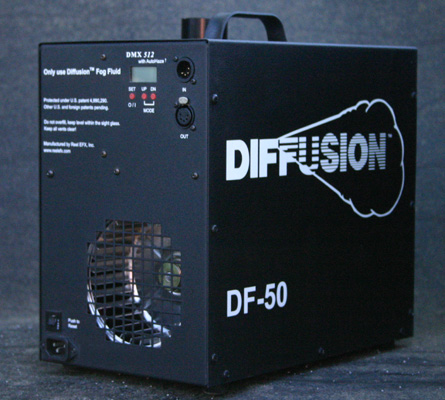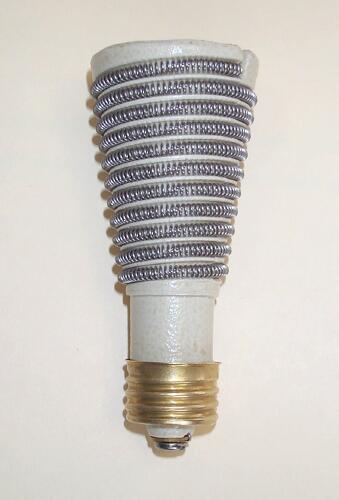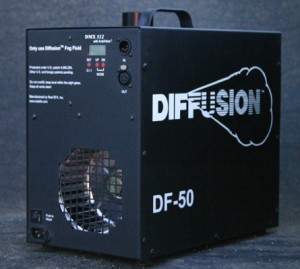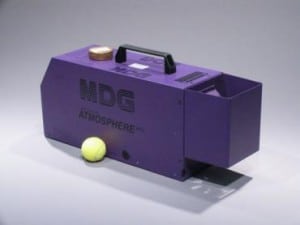
Being a lighting designer who LOVES atmospherics, especially haze, I would be prone to say “no, absolutely not, I need it!” But as anyone who has worked with Equity and the other performers’ unions before, you’d know that there are limits. Everything in moderation, I suppose.
Atmospheric products – ie, haze and fog – give shape to beams of light. These terms, along with “smoke,” are often confused, misused, and abused when talking about the general category of atmospheric products. Fog is thick – sometimes very thick – whereas haze is wispy, light, and you can generally see through it. Haze gives beautiful, lovely shape to beams of light and turn templates shining through the air into three-dimensional works of art. However, not everyone is a fan of haze. Some people are irritated by haze, not in the attitudinal sense, but in the pulmonary sense. There is also the “hypochondriac” element to consider – when you put something that people can see into the air and ask them to breathe it, you can expect that at least one in every ten people will start hacking and coughing, whether or not it irritates their breathing.

A ceramic “heater cone,” used for Sal Ammoniac powder
Atmospheric products have taken up all shapes and sizes, and chemical compositions over the years. An effective product that is horribly annoying to breathing is Sal Ammoniac – Ammonium Chloride (NH4Cl) – in a powdered form. The powder was added to a “smoker cone” or just a pan and heated up. The great thing about the product is that you need the powder, the heater cone, and an Edison base – that’s pretty much it. It produced a “smoke” that was easy to spread throughout a venue, and really did wonderful things to beams of light. It’s non-toxic, but widely known as an irritant. It certainly makes some great beam effects! What a shame, huh? The original Catch-22. I used this as recently as 1997 when designing a production in undergraduate school. It’s a bit acrid to the nose – but it’s fantastic for lighting.

The Diffusion DF-50 Cracked Oil Hazer
There’s also the big debate about cracked oil haze products versus water-based haze products. Cracked oil products are, in my humble opinion, considerably superior to the water-based haze products – but the cracked oil products, like the DF-50 hazer‘s output, have a tendency to leave a thin film on everything. If you’ve ever loaded in a rock and roll tour that’s using a cracked oil hazer, you know exactly what I mean – everything is slippery. LCD projectors also don’t really appreciate cracked oil haze – quite the contrary, as they usually get ruined after some exposure, or at least experience a degradation in quality. I will say that I have used the DF-50 in literally hundreds of shows, and I love it, no matter what.
Water-based haze products are a solution, and really are becoming a norm – one of my only gripes with cracked oil products is the “float” factor – I think it is more difficult to keep water-based haze in the air, and even. Cracked oil has often very easy to regulate, dissipate, and just plain keep looking nice.
There are tons upon tons of haze machines in the water-based category. Products like LeMaitre’s G-300, which is a hzer/fogger combo, is pretty popular, as is their Neutron XS hazer, which is pretty small and fairly cheap in price. I’ve used the Neutron XS in all kinds of environments, and it’s great for small theatres, clubs, concert venues, etc. My favorite product in the water-based haze category lately is the Unique 2 by Look Solutions USA. I bought a Unique 2 at both of the last colleges I taught, and it’s a fantastic device. You also don’t have to drain the fluid or really clean it- I left mine sitting for 3 months over a summer, and came back to the office and fired it right up. Amazing. It’s two channels – pump and fan – and DMX controlled. It’s a solid device.

The Unique 2 from Look Solutions
The Rolls Royce of hazers – at least from the people I know who use them – is the MDG hazer products. They’re expensive like a Rolls, too! They utilize a CO2 tank which needs to be filled on a regular basis – but the quality they put out is fantastic. I toured in the UK on a show, and that was the go-to hazer. Great stuff, a little high maintenance for my tastes – but that’s why they’re my tastes.

An MDG “Atmosphere” Hazer
I responded to a post at Ask.Metafilter.com a few days ago – it made me want to write about atmospherics!
As for health aspects of atmospheric products like these – I had the pleasure of sitting in on a lecture with Monona Rossol a few years ago, and she told me things about atmospherics and the lungs that I never knew. Monona is the author of The Artists’ Complete Health and Safety Guide. MSDSs can be downloaded for every product that’s out there – it’s the law! There are permissible exposure levels (PELs) for all of the products – and unions like Equity regulate how much exposure one of its union actors is allowed to have. Casts have gone on strike because of the haze levels, and some people are sensitive to some products, it’s a fact. My experience with atmospherics has been on several hundred shows across the globe; I have probably literally used hundreds of gallons of fog and haze fluid in several brands of machines, for better or for worse. I also know that I just recently had a cancer screen done on my lungs – and I’m clear. I’m sure the years of cigarettes didn’t help my lungs though. Good thing I quit three years ago.
In short, a good amount of lighting designers like haze. End of story.
The Actor’s Equity document list on atmospheric products is here.





Thanks for writing this, very informative ! I worked as a stage hand at a concert a number of years back and saw one the techs put a white powder in a hot plate a couple hours before the show (for haze) I had no clue but thought it was really cool – here is is many years later and I need to do the same thingand have been looking for this solution for a long time with no luck, until you explained it – now i just need to find some sal ammoniac and a heater and give it a shot
cant thank you enough
It’s all well and good for lighting designers to sit at their desk or in a lighting booth far removed from singing , dancing and breathing haze. DF 50 doesn’t cause one to cough, it’s detriments are much more insidious than that. It’s a silent irritant. If you care about lung health , you;ll avoid prolonged exposure to haze. I’ve been a live-theatre performer since 1975. Use of oil-based haze is not welcome whatever it’s lighting effects.
Comments are closed.